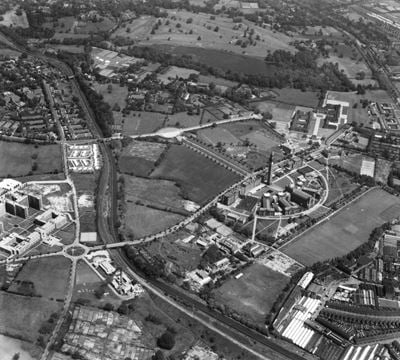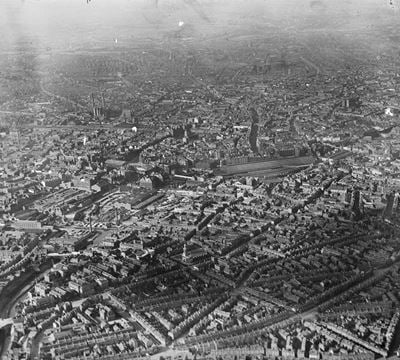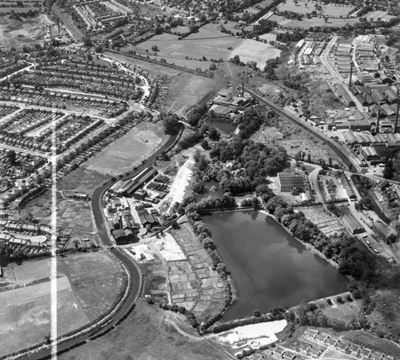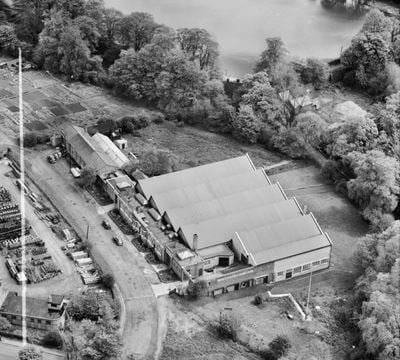Historic Birmingham
Explore hidden histories, historic photos, and things you never knew about Birmingham from the collections and archives of Historic England.
Discover Birmingham's listed buildings and places
Introducing some of Birmingham's most significant historic sites, curated from the National Heritage List for England. Skip this section and go to place by numbers
Curzon Street: The former Principal Building of the Birmi…
Birmingham
The Principal Building of Birmingham Station, the northern terminus of the London and Birmingham Railway, designed in a Greek Revival style by Philip Hardwick and opened in 1838.
21, Yateley Road B15
Birmingham
Designed by H T Buckland in 1899, 21 Yateley Road is an Arts and Crafts style house with an original interior, stained glass, and notable fireplaces.
16, Norfolk Road B15
Birmingham
Offices, formerly a house. Designed by Yeoville Thomason and built in 1854-7 for James Heacock Bodington.
80 Broad Street and boundary walls to front
Birmingham
An early-C19 former residence, later a hospital for women and children, and most recently a bar, restaurant, and nightclub, with C19, C20 and C21 extensions and alterations.
The Rotunda, including the shops in the podium below the …
Birmingham
Former office building with shops on the first and ground floors. Begun 1960, completed to revised designs 1964-5 and designed by the architect James Roberts (born 1922).
Lawley Street Railway Viaduct
Birmingham
A viaduct of 1838, designed by Joseph Locke, to take the Grand Junction railway line into the Curzon Street Terminus Station.
Uffculme School
Birmingham
The principal buildings of the former open-air school at Uffculme, built in 1911 to a design by Barry Peacock - namely the main block with attached classroom, and the three pavilion...
The Black Horse public house
Birmingham
A public house, designed by Francis Goldsbrough (of Bateman and Bateman) for the brewers John Davenport & Sons and built in 1929-30 in a late-medieval and Tudor style, designed to represent...
Roman Catholic Church of Our Lady of the Rosary and St Th…
Birmingham
A Roman Catholic parish church. 1932-4. Repaired and restored in the 1940s. Designed by George Drysdale in the Lombard style, an amalgamation of Early-Christian and Romanesque styles.
Friends' Institute Building, 220 Moseley Road
Birmingham
A former Quaker meeting hall and institute building, built under the patronage of Richard Cadbury and designed by Ewan Harper. The building opened in 1897.
Birmingham Gun Barrel Proof House
Birmingham
A gun barrel proof (testing) house commissioned by the Guardians of the Birmingham Gun Barrel Proof House from John Horton and opened in 1813.
Birmingham Botanical Gardens
Birmingham
Established in the 1830s, the Birmingham Botanical Gardens highlight J.C.
School of Art, Birmingham City University
Birmingham
The School of Art at Birmingham City University, designed by Martin and Chamberlain in the late 19th century, features a Gothic style with intricate details and a striking asymmetrical...
Aston War Memorial to the 8th Battalion, The Warwickshire…
Birmingham
A regimental war memorial, unveiled in 1921 by Major General Sir Robert Fanshawe, KCB, DSO. Read the official list entry to find out more.
Witton Cemetery
Birmingham
A mid-C19 cemetery laid out to the designs of Richard Ashwell of Coventry, with buildings by R Clarke of Nottingham. Read the official list entry to find out more.
Roman Catholic Church of Our Lady Help of Christians, inc…
Birmingham
A Roman Catholic church of 1966-7 by Richard Gilbert Scott of Giles Scott, Son and Partner with coloured glass windows by John Chrestien. Read the official list entry to find out more.
Grosvenor House
Birmingham
An office building evoking the first Chicago commercial style, built in 1953-5 to a design by the British architects' firm Cotton, Ballard and Blow.
Alpha Tower
Birmingham
An office block of twenty-eight storeys, designed by George Marsh of Richard Seifert & Partners and built in 1970-72. Construction engineers were Oscar Faber & Partners.
The Listed Building (formerly Floodgate School), Digbeth …
Birmingham
A school, built in 1891 and designed by Martin and Chamberlain for the Birmingham School Board. Read the official list entry to find out more.
St James's House
Birmingham
An employers' federation headquarters, built in 1954-7 to the designs of John Madin. Read the official list entry to find out more.
Town Hall
Birmingham
The Town Hall, designed by J A Hansom and E Welch and completed by Charles Edge, features Corinthian architecture with Anglesey marble and was completed in the 19th century.
Cannon Hill Park
Birmingham
A late C19 public park laid out to designs by John Gibson. Read the official list entry to find out more.
Bhai Kanhayya House
Birmingham
The former Handsworth New Road School, a Birmingham Board School constructed to a design by Buckland and Farmer in 1901. Read the official list entry to find out more.
Parish Church of St Augustine of Hippo
Birmingham
An Anglican parish church in a C13 style, built in 1868, by Julius Alfred Chatwin (1830-1907); extended by the addition of a tower and spire to the south in 1876, also by Chatwin.
Cathedral Church of St Philip
Birmingham
St Philip's Church, an English Baroque monument designed by Thomas Archer, became a cathedral in 1905. Notable for its 1715 organ case and Burne-Jones stained glass windows.
Rowheath Pavilion
Birmingham
A sports pavilion, built c1924 to designs by John Ramsay Armstrong, set on the playing fields of the Cadbury's Chocolate Factory, Bournville. Read the official list entry to find out more.
Roman Catholic Church of St Thomas More
Birmingham
Roman Catholic Church of 1968-9 by Richard Gilbert Scott (born 1923) of Giles Scott, Son & Partner, with stained glass windows by John Chrestien.
Birmingham Children's Hospital
Birmingham
Birmingham Children's Hospital, built as Birmingham General Hospital 1893-1897 by William Henman, extended and altered during the C20. Read the official list entry to find out more.
William Mitchell murals in the pedestrian concourse of Ho…
Birmingham
Three concrete relief murals within the concourse to Hockley Flyover, designed by William Mitchell Design Consultants and constructed around 1968.
All Saints Church with attached tower and hall
Birmingham
A brick church with attached tower and hall, built 1954-1955 to the designs of Frank J Osborne, with sculptural work by William Bloye. Read the official list entry to find out more.
50 Wake Green Road
Birmingham
A suburban house, dated 1907, designed by George Edward Pepper in an Arts and Crafts style. Read the official list entry to find out more.
The Close at Westhill College
Birmingham
A pair of semi-detached Arts and Crafts style houses by W Alexander Harvey and W Graham Wicks, built between 1911-1913, as part of a group designed for the Society of Friends in memory of...
Catholic Cathedral Church of St Chad
Birmingham
A Cathedral Church built 1839-1841 from designs by A W Pugin, with C19 and C20 alterations and additions by E W Pugin and Sebastien Pugin Powell, and fittings by John Hardman and Co.
Nos. 93-95 Hagley Road, Edgbaston
Birmingham
A pair of semi-detached houses of early or mid-C19 date in a classical style with late-C20 extensions to the rear. Read the official list entry to find out more.
University of Birmingham Lodge, Gates, Gate Piers and Wall
Birmingham
A lodge, gate, gate piers and walling to Birmingham University campus, built to the designs of Aston Webb and Ingress Bell, between 1904 and 1909.
Red Lion, Erdington
Birmingham
A public house of 1899, designed by Wood and Kendrick for Mitchells and Butlers in a loosely Jacobean style and including a lavishly-decorated, ceramic bar front made by Craven Dunnill of...
Bournville Quaker Meeting House
Birmingham
Quaker Meeting House, 1905, by W A Harvey, with subsequent phases of extension. Read the official list entry to find out more.
Fire Station and Firemen's Homes
Birmingham
A fire station built from 1929 to 1930 to the designs of Herbert H Humphries, the City Surveyor for Birmingham, with CA Horton Ltd. as builders.
Explore more
See more listed placesHistoric Birmingham through time
The National Heritage List for England contains hundreds of details about buildings and places, including the periods in which they were built and the uses they've had over the years. Explore how your local area has changed through time. Skip this section and go to aerial photos
Prehistoric Before AD 43
Prehistory covers a million years of human occupation before the Roman invasion and the introduction of writing. Primarily hunter-gatherers of several human species including Neanderthals, the peoples moved across Europe, hunting animals, exchanging ideas and developing complex culture and belief systems including burial rites and astronomical understanding, as at Stonehenge for example.
We don't have an image for any of these list entries yet
Roman AD 43 to AD 410
Britain was invaded by four legions of the Roman army in AD 43, who relatively rapidly conquered England from landing points in Kent. Parts of Wales and Scotland soon followed.
Roman culture brought urbanism, monumental buildings, wide-ranging religious beliefs, writing, and strong social hierarchy. The Roman administrative system was withdrawn in AD 410.
Early medieval AD 410 to AD 1066
This period, often associated in England with Anglo-Saxons and Vikings, saw a reduction in urban living from the Roman period and increased migration from northern Europe.
Traces of this period can be found in cemeteries, particularly in artefacts and in some of the very early churches, as this period also saw the growth of Christianity in Britain.
Medieval AD 1066 to AD 1540
This period, sometimes known as the Middle Ages, began with the Norman invasion in AD 1066. It saw a significant rise in military and defensive buildings such as castles and earthworks, as well as religious houses dominating a largely agricultural landscape.
The monarchy and Church dominated the period, which also saw the break with the Roman Catholic Church and the English reformation.
Post medieval AD 1540 to AD 1901
The Post-Medieval period brought seismic changes to life in England, with religious reformation leading to the democratization of worship and the destruction of hundreds of religious houses.
In parallel, there was a huge expansion of scientific study and enlightenment that permanently altered the nation's social structure and landscape. Industrialization and mass production lead to wider global trade, emigration, and immigration.
20th century AD 1901 to AD 2000
The 20th century saw an incredible expansion of England's transport networks, with suburban growth shadowing rapid infrastructural expansion. The establishment of state schools, hospitals, and modern technical colleges, with new architectural styles, radically changed the appearance of towns and cities.
Two catastrophic world wars and the 1918 pandemic also brought unprecedented change, altering England's built environment and social structures forever.
Prehistoric Before AD 43
Prehistory covers a million years of human occupation before the Roman invasion and the introduction of writing. Primarily hunter-gatherers of several human species including Neanderthals, the peoples moved across Europe, hunting animals, exchanging ideas and developing complex culture and belief systems including burial rites and astronomical understanding, as at Stonehenge for example.
We don't have an image for any of these list entries yet
Roman AD 43 to AD 410
Britain was invaded by four legions of the Roman army in AD 43, who relatively rapidly conquered England from landing points in Kent. Parts of Wales and Scotland soon followed.
Roman culture brought urbanism, monumental buildings, wide-ranging religious beliefs, writing, and strong social hierarchy. The Roman administrative system was withdrawn in AD 410.
Early medieval AD 410 to AD 1066
This period, often associated in England with Anglo-Saxons and Vikings, saw a reduction in urban living from the Roman period and increased migration from northern Europe.
Traces of this period can be found in cemeteries, particularly in artefacts and in some of the very early churches, as this period also saw the growth of Christianity in Britain.
Medieval AD 1066 to AD 1540
This period, sometimes known as the Middle Ages, began with the Norman invasion in AD 1066. It saw a significant rise in military and defensive buildings such as castles and earthworks, as well as religious houses dominating a largely agricultural landscape.
The monarchy and Church dominated the period, which also saw the break with the Roman Catholic Church and the English reformation.
Post medieval AD 1540 to AD 1901
The Post-Medieval period brought seismic changes to life in England, with religious reformation leading to the democratization of worship and the destruction of hundreds of religious houses.
In parallel, there was a huge expansion of scientific study and enlightenment that permanently altered the nation's social structure and landscape. Industrialization and mass production lead to wider global trade, emigration, and immigration.
20th century AD 1901 to AD 2000
The 20th century saw an incredible expansion of England's transport networks, with suburban growth shadowing rapid infrastructural expansion. The establishment of state schools, hospitals, and modern technical colleges, with new architectural styles, radically changed the appearance of towns and cities.
Two catastrophic world wars and the 1918 pandemic also brought unprecedented change, altering England's built environment and social structures forever.
Aerial photos of Birmingham
Historic aerial photography shows the growth and changes in England's urban and rural landscapes, revealing secrets that are impossible to see from the ground. Skip this section and go to archive images

Edgbaston
The University of Birmingham, Edgbaston, 1928

Edgbaston
The University of Birmingham, Edgbaston, 1948

Birmingham
Birmingham New Street Station and town centre, Birmingham, 1920

Birmingham
Victoria Square showing the construction of the Central Library, Birmingham, 1969

Birmingham
St Mary's Church, the General Hospital and Electric Supply Station, Birmingham, 1921

Birmingham
Factories along Princip Street, Birmingham, 1951

King'S Norton
Lifford Chemical Works, Lifford Reservoir and environs, King's Norton, 1951

Lifford
The Worcester Brass Co Ltd Works on Ebury Road, Lifford, 1952

Witton
The General Electric Company Works, Witton, 1921

Witton
The General Electric Co Ltd Witton Works and environs, Witton, 1952
Historic England Archive images of Birmingham
The Historic England Archive holds and cares for over 15 million images, from the 1850s to the present day. Discover stunning images of Birmingham's past. Skip this section and go to stories about heritage
Eric de Mare
Witton, Birmingham, Birmingham
Date created: 1945 - 1980
Interior view of the General Electrical Company Witton Works showing an aerial walkway.
John Gay Collection: Modern Architects
Edgbaston, Birmingham, Birmingham
Date created: 1973 - 1979
Part of the exterior of the Employment Rehabilitation Centre in Edgbaston showing the visitors entrance on the north elevation
John Laing Collection
Edgbaston Campus, Birmingham, Birmingham
Date created: 28 Sep 1966
View of the Radiation and Physics Block at Birmingham University
London, Midland and Scottish Railway Company
Bournville, Birmingham
Date created: 01 May 1928
A view of a loading bay at Cadbury's Chocolate Factory, with boxes of confectionary being loaded into delivery vans
Nigel Temple Collection of Postcards of Parks and Gardens
Moseley, Birmingham
Date created: 1910 - 1940
GENERAL VIEW ACROSS LAKE TO HOUSE
Eric de Mare
Edgbaston, Birmingham, Birmingham
Date created: 1964 - 1980
General view of the Department of Commerce and Soial Sciences at the University of Birmingham showing part of a two storey faculty building.
John Gay Collection: Modern Architects
Edgbaston, Birmingham, Birmingham
Date created: 1973 - 1979
A view looking along the east elevation of the Employment Rehabilitation Centre in Edgbaston
John Laing Collection
Edgbaston Campus, Birmingham, Birmingham
Date created: 28 Sep 1966
View of the Radiation and Physics Block at Birmingham University
London, Midland and Scottish Railway Company
Highgate, Birmingham
Date created: 1930 - 1935
The front elevation of Stratford House on Stratford Place, with a female figure stood at the edge of the frame
Nigel Temple Collection of Postcards of Parks and Gardens
Moseley, Birmingham
Date created: 1900 - 1930
GENERAL VIEW OF MOSELEY PARK POOL
John Laing Collection
Edgbaston Campus, Birmingham, Birmingham
Date created: 28 Sep 1966
View of the Radiation and Physics Block at Birmingham University showing overhead walkway and clock tower
Nigel Temple Collection of Postcards of Parks and Gardens
Edgbaston, Birmingham, Birmingham
Date created: 1900 - 1909
GENERAL VIEW FROM RIVER
Stories about heritage in Birmingham
Historic England publishes news, blogs, videos and podcasts celebrating England's heritage. Discover the stories we have about Birmingham. Skip this section and go to education
A Brief Introduction to Semi-Detached Housing
Mentions Birmingham
Semi-detached housing is the most prevalent type of housing in England today, making up one third of the housing stock.
A History of Bradford in 10 Places
Mentions Town Hall, Birmingham
Discover the history of Bradford's buildings including Cartwright Hall, Lister Mills, UNESCO site Saltaire, Bradford Cathedral and Brontë Parsonage...
6 Places Connected to Queer Jewish History in London
Mentions Birmingham
Discover the places connected to queer Jewish history in London including Hyde Park, Gateways Club in Chelsea, and the Colony Room Club.
Meet Gwen Lally, the World’s Pageant Master
Mentions Birmingham
We know that there was more to the world’s pageant master than met the eye.
At the Mermaid: Punk, Metal and Grindcore in 1980s Birmingham
Mentions Birmingham
Discover the Mermaid pub, Birmingham, a centre for heavy metal and grindcore music in the 1980s for bands like Napalm Death.
The Life, Love and Legacy of Feminist Pioneer Rose Sidgwick
Mentions Great Hall and Quadrant Range, Birmingham
Unpick the legacy of the historian who made pioneering contributions to history and international feminism.
A Brief Introduction to Romani Gypsy Heritage in England
Mentions Birmingham
Discover the Romani Gypsy and Traveller history and heritage in England through the art, culture and landscapes of the country.
The Story of the Nightingale, Birmingham’s Longest-running Gay Club
Mentions Birmingham
Explore the history of one of the most iconic queer landmarks in Birmingham.
Mentions Birmingham
The Mermaid was a large, dilapidated pub in Sparkhill, a working-class neighbourhood 3 miles south of Birmingham city centre.
The Pub That Created Grindcore: Inside the Mermaid’s Legendary Scene
The Mermaid was a large, dilapidated pub in Sparkhill, a working-class neighbourhood 3 miles south of Birmingham city centre. The Mermaid was vital to the early days of the band Napalm Death and the creation of a new heavy metal subgenre: Grindcore.
Mentions Birmingham
Ever swum in an Edwardian swimming pool? Join GB swimmer Alice Dearing to explore the oldest surviving Grade II* bath house in England that is still...
Visiting Birmingham's Moseley Road Baths with Swimmer Alice Dearing
Ever swum in an Edwardian swimming pool? Join GB swimmer Alice Dearing to explore the oldest surviving Grade II* bath house in England that is still operating as a pool.
Mentions Birmingham
41 places across England that were at the centre of suffragette action, from mass meetings and smashed windows to prison hunger strikes and post box...
Sites of Suffragette Protest and Sabotage
41 places across England that were at the centre of suffragette action, from mass meetings and smashed windows to prison hunger strikes and post box fires, have been officially recognised.
Mentions Birmingham
The 'Relaxed @ Newman Bros.' factory tour, specifically designed for people on the autistic spectrum by Adam Sutcliffe-Brown, has connected the Coffin...
The Relaxed @ Newman Bros Tour at the Coffin Works in Birmingham
The 'Relaxed @ Newman Bros.' factory tour, specifically designed for people on the autistic spectrum by Adam Sutcliffe-Brown, has connected the Coffin Works museum in Birmingham with a group it had failed to reach.
Update on Staffordshire Hoard Research
Mentions Birmingham
Update of progress of research into the stunning Anglo-Saxon Staffordshire Hoard.
30 Years of Flying in the North
Mentions Birmingham
Celebrating the achievements of Historic England's aerial recording programme in the North of England.
New Funding to Celebrate Rural and Coastal Working-Class Heritage
Mentions Birmingham
Historic England is funding new projects to explore untold stories and celebrate the people and places at the heart of our history.
Birmingham’s Craven Arms Pub Listed at Grade II
Mentions The Craven Arms, The Craven Arms, Birmingham
A pub in Birmingham City Centre featuring a striking two-tone tiled exterior, has been granted listed status.
Birmingham’s Cavern Club ‘The Cradle of Heavy Metal’ Secures Grade II Listing
Mentions The Crown Hotel, Station Street, Birmingham, Birmingham
Heritage music venue recognised for role played in the development of heavy metal music and the career of famous Birmingham based band, Black Sabbath.
High Streets Heritage Action Zone Programme Success Celebrated
Mentions Birmingham
Historic England’s 4-year High Streets Heritage Action Zone programme has unlocked the potential of 67 historic high streets across England.
New Funding to Uncover and Celebrate Working Class Heritage
Mentions Birmingham
Historic England's Everyday Heritage Grant programme is funding 56 new projects across the nation, telling the stories of working class heritage.
Uncovering Digbeth's heritage
Mentions Birmingham
New Historic England research highlights the threatened special character of Digbeth, an inner-city area in Birmingham
Explore your social history through photos
Over 10,000 images from the Historic England Archive have been specially selected and re-captioned for teachers, students, and anyone who wants to learn more about heritage in their local area. Skip this section and go to grant-aided places
Workers housing, Willow Street, Bournville, West Midlands
Period: Victorian (1837 - 1901)
From 1895 Bournville was developed as a model village associated with the chocolate factory of the philanthropist George Cadbury.
Workers housing, Willow Street, Bournville, West Midlands
Worcester Bank, Birmingham, West Midlands
Period: Victorian (1837 - 1901)
This is a banking hall at the Worcester Bank on Colmore Row, Birmingham.
Worcester Bank, Birmingham, West Midlands
Tags
Villa Road, Handsworth, Birmingham, West Midlands
Period: Victorian (1837 - 1901)
A view looking east along Villa Road showing four women cycling towards Villa Cross and the pavement shaded by shop awnings.
Villa Road, Handsworth, Birmingham, West Midlands
Victoria Law Courts, Corporation Street, Birmingham, West Midlands
Period: Victorian (1837 - 1901)
The Corporation Street elevation of the Victoria Law Courts. The Victoria Law Courts are built in characteristic Victorian red brick and terracotta.
Victoria Law Courts, Corporation Street, Birmingham, West Midlands
Tags
Town Hall, Victoria Square, Birmingham, West Midlands
Period: Georgian (1714 - 1836)
Birmingham Town Hall viewed from the east with the Peel Statue in the foreground.
Town Hall, Victoria Square, Birmingham, West Midlands
Town Hall, Birmingham, West Midlands
Period: World War Two (1939 - 1945)
View of the Town Hall with banner covering one side, promoting Warship Week, October 18th - 26th.
Town Hall, Birmingham, West Midlands
The Standard Works, Birmingham, West Midlands
Period: Victorian (1837 - 1901)
The Standard Works was built in 1879-80 bythe architect Thomas F Williams.
The Standard Works, Birmingham, West Midlands
The Roundhouse, Sheepcote Street, Birmingham, West Midlands
Period: Victorian (1837 - 1901)
The Roundhouse, to the left of the Birmingham Canal, was built in 1840 as a mineral and coal wharf for the London & North Western Railway.
The Roundhouse, Sheepcote Street, Birmingham, West Midlands
Visit grant-aided places near you
These places and buildings have been helped by Historic England's financial grants. Find local heritage in your neighbourhood that you never knew existed! Please note that opening times may vary. Skip this section and go to related locations
Newman Brothers Coffin Fitting Works, 13-15 Fleet Street
This purpose-built factory, dating from 1894, was used for manufacturing fittings, funerary shrouds, and coffin linings.
Winson Green Seventh Day Adventist Church, 60 Beeton Road
Built in 1904, the historic parish church in Winson Green features a functional pipe organ, designed by William Bidlake.
Highbury Hall, 4 Yew Tree Road
Highbury Hall is a grade II* Victorian mansion built in 1876 for Joseph Chamberlain, set in its own grounds.
The Roundhouse, 101 Vincent Street
A horseshoe shaped building with gatehouses and inner courtyard. Visitor Centre and catering space available for public, with office space for tenants.
Highbury Gardens, 4 Yew Tree Road
The building is a Venetian Gothic, Ruskin inspired Victorian mansion house set in a designed landscape which is used to inspire the architectural...
Discover more Heritage nearby
Have you got another local place, or somewhere you're planning to visit? Take a look at these other places nearby


